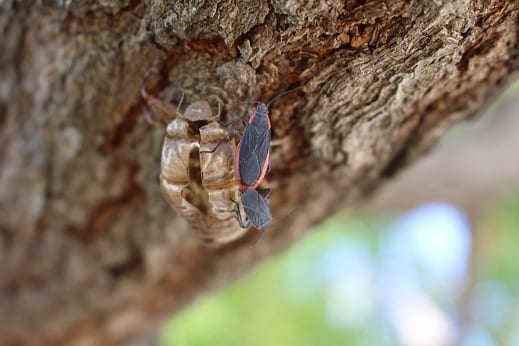–by Dr. Raymond Cloyd
Red-shouldered bug, Jadera haematoloma, nymph and adult populations can be found gathering on the south and west sides of golden-rain trees, homes, and buildings; sometimes in extensive numbers. These insects are similar in appearance to the boxelder bug, Leptocoris trivitatus (Figure 1);
Fig 1. Adult boxelder bug (Author–Raymond Cloyd, KSU)
however, adults lack the central red stripe on the pronotum of the thorax, and red markings on the wings. Instead, red-shouldered bugs have a distinctive red line on both sides of the thorax or ‘shoulder.’ Red-shouldered bugs are somewhat flattened and 3/8 to 5/8 inches long (Figure 2).
Fig 2. Adult red-shouldered bug (Author–Raymond Cloyd, KSU)
Nymphs resemble the adults in appearance but are more oval-shaped and have wing pads—but not wings. Adults overwinter in a protected location including homes. They will also overwinter in the soil or leaf litter near building foundations. Red-shouldered bugs feed primarily on the seeds of the golden-rain tree, Koelreuteria paniculata. Both nymphs and adults can be found aggregating on the trunk of trees (Figure 3).
Fig 3. Red-shouldered bugs aggregating on the bark of golden-rain tree (–Raymond Cloyd, KSU)
Red-shouldered bugs can become a nuisance later in the season when they enter homes and buildings to overwinter. They do not transmit any diseases that we are aware of. The red-shouldered bug is native to the United States.
The main way to manage red-shouldered bugs from entering homes and buildings is by sealing or caulking cracks and crevices. Applying an insecticide to the outside of a home or building such as carbaryl (Sevin) or one of the pyrethroid-based insecticides (e.g. bifenthrin, cyfluthrin, or permethrin) may reduce the number of adults that enter homes or buildings. Once red-shouldered bugs enter homes or buildings, however, there are few effective management options other than vacuuming them up, and disposing of them from the bags outdoors. If you have any questions regarding red-shouldered bugs contact your local extension office or a university-based extension entomologist.


